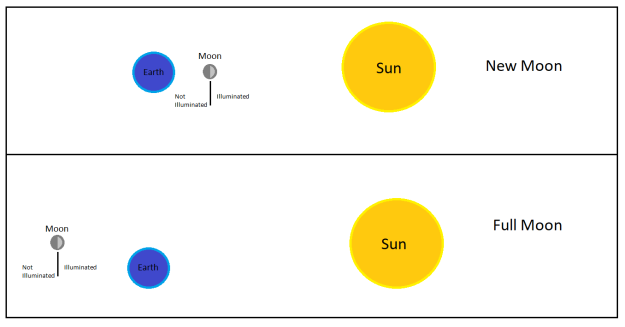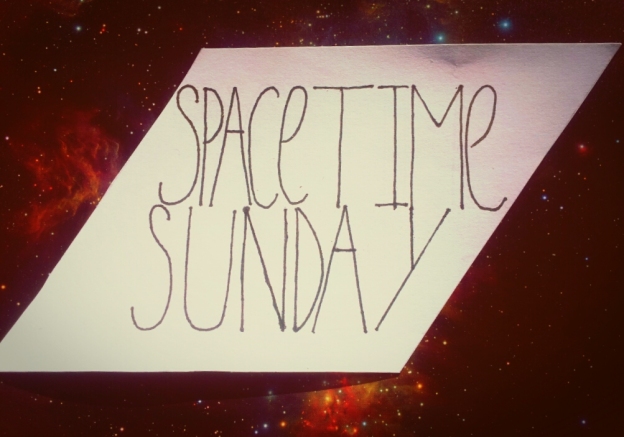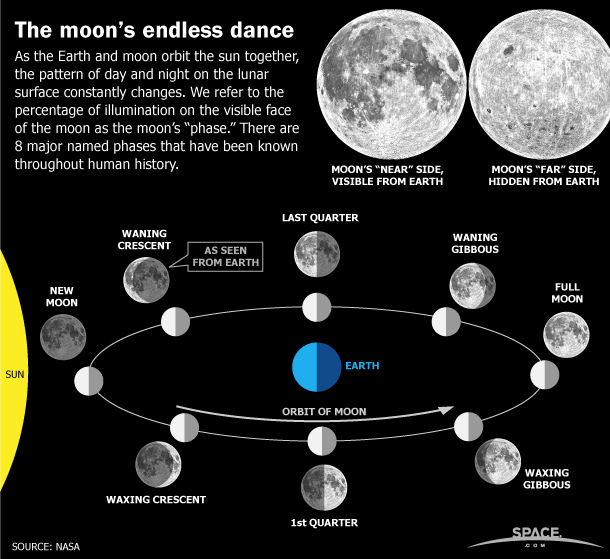Greetings, friends! This week we’re talking Luna. What gives the Moon phases?
The Moon is a celestial body that affects our daily lives, through its gravitational effects on tides in a direct sense, but it also has cultural and social effects; many religious holidays are based on the Lunar calendar, for example Easter is always changing dates because it is on the first Sunday after the first full Moon on or after the vernal equinox, and a Lunar cycle is about 27 days, not the same as a calendar month.
But when you look up at night, or the day, at the Moon, do you think about why it looks the way it does then, and different at other times?
Moonlight is reflected sunlight. Light is emitted from the Sun in all directions, and is bouncing off objects to enable us to see them. This reflecting light illuminates surfaces facing the Sun, and we see a certain amount of the illumination as viewed from Earth.
Similarly, the surface not facing the Sun can’t be illuminated, and so that part is in darkness.
With the Moon, it is all about the angles we see it at. The Moon, like Earth, is always half illuminated, but we can’t always see that. A new moon is essentially no Moon seen from Earth, because the Moon is directly between the Sun and Earth and we can’t see any of the illuminated half. A full moon is when the moon is on the opposite side of the Earth to the Sun and so we can see all of the illuminated half. Here’s some handy drawings I crafted in the well known scientific tool Microsoft Paint, not to scale, of course:

Here are some important points about trying to understand images like this excellent example:
- These are not to scale.
- The Earth does not block the light from the Sun to the Moon to make phases. When the Earth blocks the light from the Sun to the Moon, it is called a Lunar eclipse.
- Looking at images like this will probably not help you fully understand this process.
- The Earth is also half lit; I just didn’t want to clutter the image.
- 2D images can only go so far to help you understand a 4D system (time is a dimension, especially when talking about things that change over time).
So, the Moon orbits around the Earth, and the Earth orbits around the Sun. As the Moon is in different positions relative to Earth and the Sun, different amounts of it appear to be lit as viewed from earth.
The best way to understand this though, is to make a mini system.
You will need:
A golf ball (ready made craters!) or other spherical object on a stick of some sort
A source of light such as a light bulb, torch, or some other static and accessible object
A dark room or space (get it)
To construct your mini Earth-Moon-Sun system:
Hold the moon at arm’s length by the holding stick, and stand with your back facing your sun, but without your shadow blocking your moon. This is your full moon.
Move your moon around by rotating your body. Notice what happens to the shadow as different amounts of it look illuminated from Earth (your brain).
If you wanted to go crazy, move around your Sun and make your Moon rotate around you, and explore the effects of that. Try not to fall over though.
Check out this Youtube video for a demo.
The one thing you might find challenging to explore with this method is the different times a Moon rises and sets. For example, a full Moon is seen at night, which you can see by looking at the premium image I crafted above; it is on the opposite side of Earth to the Sun, and since that side of the Earth is in shadow, it is what us Earthlings living in the shadow call night. But you can think about when you’re seeing both your sun and moon as you rotate to explore why the moon is sometimes out in the day.
Here’s another image to help you learn the names for the different phases of the Moon. The inner ring of Moons show the illumination as viewed from outside the system (like we said, always half lit), and the outer ring of Moons show what the Moon looks like as viewed from Earth, at each position in the Moon’s orbit around the Earth.
One thing to note is the fact that a Moon that appearing half illuminated from Earth is called a Quarter Moon. That’s because there’s always half the Moon that we can’t see, and a half of a half is a quarter! You have to wonder why a Full Moon isn’t called a Half Moon, following that logic? Kooky.
That’s all for now, but I thoroughly enjoy the Moon, and there’s more coming about this top notch rock. This is also, of course, not everything there is to know about moon phases, and you can read more here:
Nasa’s Moon page
Moon Phases at timeanddate
The Space.com article the last image is from

